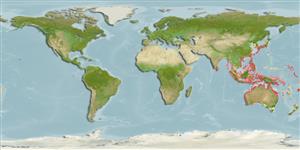>
Kurtiformes (Nurseryfishes, cardinalfishes.) >
Apogonidae (Cardinalfishes) > Apogoninae
Eponymy: Dr Ludwig Heinrich Philipp Döderlein (1855–1936) was a zoologist and palaeontologist. [...] (Ref. 128868), visit book page.
More on authors: Jordan & Snyder.
Environment: milieu / climate zone / depth range / distribution range
Ecologia
marinhas associadas(os) a recifes; intervalo de profundidade 0 - 10 m (Ref. 93839). Subtropical
Western Pacific: subtropical, from southern Japan to Taiwan, then from subtropical Australia to New Caledonia and the Kermadec Islands.
Tamanho / Peso / Idade
Maturity: Lm ? range ? - ? cm
Max length : 14.0 cm TL macho/indeterminado; (Ref. 559)
Descrição suscinta
Chaves de identificação | Morfologia | Morfometria
Espinhos dorsais (total) : 8; Raios dorsais (total) : 9; Espinhos anais: 2; Raios anais : 8. Distinguished by having the following characteristics: dorsal fin rays VII-I, 9; anal fin rays II, 8; pectoral fin rays 15; pelvic fin rays I, 5; pored lateral line scales 24; predorsal scales 3; circumpeduncular scales 12; body pinkish brown, with four dark brown stripes on lateral surface of body; third stripe posteriorly not reaching to a black spot on caudal fin base; caudal fin base spot subequal in size to pupil diameter (Ref. 93839).
Commonly occurs in rocky areas near shore and abundant on ledges. Solitary but pair off during breeding. Mouth brooding is done by the male. Nocturnal species (Ref. 7300).
Ciclo de vida ou comportamento de acasalamento
Maturidade | Reprodução | Desova | Ovos | Fecundidade | Larvas
Mouthbrooders (Ref. 240). Distinct pairing during courtship and spawning (Ref. 205).
Randall, J.E., G.R. Allen and R.C. Steene, 1990. Fishes of the Great Barrier Reef and Coral Sea. University of Hawaii Press, Honolulu, Hawaii. 506 p. (Ref. 2334)
Status na Lista Vermelha da UICN (Ref. 130435: Version 2024-2)
Ameaça para os humanos
Harmless
Uso pelos humanos
Ferramentas
Relatórios especiais
Baixar XML
Fontes da internet
Estimates based on models
Preferred temperature (Ref.
123201): 20 - 28.9, mean 27.6 °C (based on 1621 cells).
Índice de diversidade filogenética (Ref.
82804): PD
50 = 0.5000 [Uniqueness, from 0.5 = low to 2.0 = high].
Bayesian length-weight: a=0.01413 (0.00826 - 0.02417), b=3.18 (3.03 - 3.33), in cm total length, based on LWR estimates for this species & Genus-body shape (Ref.
93245).
Nível Trófico (Ref.
69278): 3.6 ±0.56 se; based on food items.
Generation time: 0.5 ( na - na) years. Estimated as median ln(3)/K based on 1
growth studies.
Resiliência (Ref.
120179): Elevada, tempo mínimo de duplicação da população menor que 15 meses (Preliminary K or Fecundity.).
Fishing Vulnerability (Ref.
59153): Low vulnerability (10 of 100).
Nutrients (Ref.
124155): Calcium = 132 [44, 409] mg/100g; Iron = 1.72 [0.67, 4.15] mg/100g; Protein = 19.5 [17.8, 21.2] %; Omega3 = 0.153 [0.042, 0.558] g/100g; Selenium = 28.6 [6.6, 111.8] μg/100g; VitaminA = 9.24 [1.28, 80.05] μg/100g; Zinc = 1.73 [0.80, 3.44] mg/100g (wet weight);
